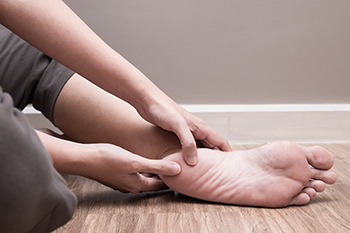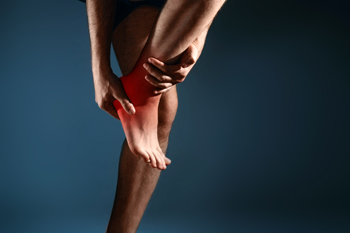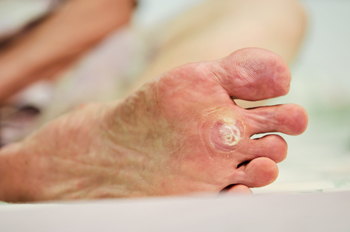Items filtered by date: August 2022
Heel Pain Can Come From Various Sources

There are many different reasons why people can feel heel pain. It can be a result of having Achilles tendonitis, a heel spur, or plantar fasciitis. These are the most common causes, and there are various ways the heel bone can be negatively affected. Heel pain can consist of a stabbing, burning pain, or it may be a chronic dull ache. It may be worse upon waking up in the morning, and walking can be difficult. Plantar fasciitis is the inflammation of the plantar fascia, the band of tissue that runs along the sole of the foot. Its function is to connect the heels to the toes, in addition to providing stability to the arch. People who enjoy running or who frequently participate in jumping activities may develop this condition, and it can cause severe pain and discomfort. A heel spur is defined as a bony growth that forms on the back of the heel bone, and it can come from extra bone tissue that can be caused by plantar fasciitis. The Achilles tendon is located in the calf, and it connects the heel to the calf muscles. This tendon can become torn or ruptured from an injury, and cause heel pain. If you are experiencing heel pain for any reason, it is strongly advised that you are under the care of a podiatrist who can determine what the cause is, and offer you correct treatment options.
Many people suffer from bouts of heel pain. For more information, contact one of our podiatrists of Palmetto Podiatry Group of Anderson. Our doctors can provide the care you need to keep you pain-free and on your feet.
Causes of Heel Pain
Heel pain is often associated with plantar fasciitis. The plantar fascia is a band of tissues that extends along the bottom of the foot. A rip or tear in this ligament can cause inflammation of the tissue.
Achilles tendonitis is another cause of heel pain. Inflammation of the Achilles tendon will cause pain from fractures and muscle tearing. Lack of flexibility is also another symptom.
Heel spurs are another cause of pain. When the tissues of the plantar fascia undergo a great deal of stress, it can lead to ligament separation from the heel bone, causing heel spurs.
Why Might Heel Pain Occur?
- Wearing ill-fitting shoes
- Wearing non-supportive shoes
- Weight change
- Excessive running
Treatments
Heel pain should be treated as soon as possible for immediate results. Keeping your feet in a stress-free environment will help. If you suffer from Achilles tendonitis or plantar fasciitis, applying ice will reduce the swelling. Stretching before an exercise like running will help the muscles. Using all these tips will help make heel pain a condition of the past.
If you have any questions please contact our office located in Anderson, SC . We offer the newest diagnostic and treatment technologies for all your foot and ankle needs.
Several Reasons That Foot Pain May Develop

The foot is a complex structure. There are several areas where foot pain can develop, including the toes, heels, soles, and arches. Pain can negatively affect the overall body and can cause difficulty in completing daily activities. A common cause of foot pain can be from wearing shoes that do not fit correctly, frequently wearing high heels, or increasing speed and intensity too quickly while running. There may be existing medical conditions that can lead to foot pain. These include arthritis, foot ulcers, or clogged arteries in the legs and feet. Many pregnant women may have foot pain from the added weight of the fetus and thickened blood during pregnancy. Having an ingrown toenail is a common source of foot pain, in addition to having a bunion, hammertoe, or athlete’s foot. Mild relief may come from elevating the feet as often as possible, and using foot pads on the affected area may temporarily feel good. If you have any type of foot pain, it is strongly advised that you are under the care of a podiatrist who can properly diagnose and treat your condition.
Foot Pain
Foot pain can be extremely painful and debilitating. If you have a foot pain, consult with one of our podiatrists from Palmetto Podiatry Group of Anderson. Our doctors will assess your condition and provide you with quality foot and ankle treatment.
Causes
Foot pain is a very broad condition that could be caused by one or more ailments. The most common include:
- Bunions
- Hammertoes
- Plantar Fasciitis
- Bone Spurs
- Corns
- Tarsal Tunnel Syndrome
- Ingrown Toenails
- Arthritis (such as Gout, Rheumatoid, and Osteoarthritis)
- Flat Feet
- Injury (from stress fractures, broken toe, foot, ankle, Achilles tendon ruptures, and sprains)
- And more
Diagnosis
To figure out the cause of foot pain, podiatrists utilize several different methods. This can range from simple visual inspections and sensation tests to X-rays and MRI scans. Prior medical history, family medical history, and any recent physical traumatic events will all be taken into consideration for a proper diagnosis.
Treatment
Treatment depends upon the cause of the foot pain. Whether it is resting, staying off the foot, or having surgery; podiatrists have a number of treatment options available for foot pain.
If you have any questions, please feel free to contact our office located in Anderson, SC . We offer the newest diagnostic and treatment technologies for all your foot care needs.
Causes and Remedies of Poor Foot Circulation

One of the symptoms of poor circulation is having cold feet. Additional symptoms include swelling, chronic pain, difficulty moving the feet. Many people feel a tingling or numbing sensation in their feet, which may make their feet feel heavy. The common reasons poor circulation may be prevalent among seniors include having diabetes, being overweight, smoking, and living a sedentary lifestyle. There also may be existing medical conditions that contribute to having poor circulation. Among them are having peripheral artery disease (PAD), atherosclerosis, or a venous insufficiency. Circulation can be improved by making lifestyle changes. It is beneficial to incorporate a simple exercise routine daily, and it is important to consume a healthy diet. Some patients find relief when they elevate their feet, and it may help to wear compression stockings. If you would like more information about the causes and remedies of poor circulation in the feet, please confer with a podiatrist.
While poor circulation itself isn’t a condition; it is a symptom of another underlying health condition you may have. If you have any concerns with poor circulation in your feet contact one of our podiatrists of Palmetto Podiatry Group of Anderson. Our doctors will treat your foot and ankle needs.
Poor Circulation in the Feet
Peripheral artery disease (PAD) can potentially lead to poor circulation in the lower extremities. PAD is a condition that causes the blood vessels and arteries to narrow. In a linked condition called atherosclerosis, the arteries stiffen up due to a buildup of plaque in the arteries and blood vessels. These two conditions can cause a decrease in the amount of blood that flows to your extremities, therefore resulting in pain.
Symptoms
Some of the most common symptoms of poor circulation are:
- Numbness
- Tingling
- Throbbing or stinging pain in limbs
- Pain
- Muscle Cramps
Treatment for poor circulation often depends on the underlying condition that causes it. Methods for treatment may include insulin for diabetes, special exercise programs, surgery for varicose veins, or compression socks for swollen legs.
As always, see a podiatrist as he or she will assist in finding a regimen that suits you. A podiatrist can also prescribe you any needed medication.
If you have any questions, please feel free to contact our office located in Anderson, SC . We offer the newest diagnostic and treatment technologies for all your foot care needs.
Are You Suffering From Ingrown Toenails?
When Plantar Warts Are Painful

Plantar warts are small patches of hardened growths that can form on the bottom, or sole, of someone’s feet. These warts are spread from one person to another through the human papillomavirus (HPV). Importantly, plantar warts are significantly different from corns, which form on the top of toes in response to friction or stress. Many cases of plantar warts may not cause the patient any pain. However, there are instances in which warts might be painful. If you have a larger plantar wart that essentially splits open, this could be a sign that pain might be felt later. This is because the tissue underneath a larger plantar wart can become irritated, which might ultimately result in bleeding and pain. Additionally, plantar warts can also cause the patient pain depending on where they are located. Warts that are situated on the skin folds of the toes can be especially painful. If a wart is growing inward, typically in response to the body putting pressure on the bottoms of feet when standing, then this can also be particularly painful. Contact a podiatrist for help with your plantar warts.
Plantar warts can be very uncomfortable. If you need your feet checked, contact one of our podiatrists from Palmetto Podiatry Group of Anderson. Our doctors will assist you with all of your foot and ankle needs.
About Plantar Warts
Plantar warts are the result of HPV, or human papillomavirus, getting into open wounds on the feet. They are mostly found on the heels or balls of the feet.
While plantar warts are generally harmless, those experiencing excessive pain or those suffering from diabetes or a compromised immune system require immediate medical care. Plantar warts are easily diagnosed, usually through scraping off a bit of rough skin or by getting a biopsy.
Symptoms
- Lesions on the bottom of your feet, usually rough and grainy
- Hard or thick callused spots
- Wart seeds, which are small clotted blood vessels that look like little black spots
- Pain, discomfort, or tenderness of your feet when walking or standing
Treatment
- Freezing
- Electric tool removal
- Laser Treatment
- Topical Creams (prescription only)
- Over-the-counter medications
To help prevent developing plantar warts, avoid walking barefoot over abrasive surfaces that can cause cuts or wounds for HPV to get into. Avoiding direct contact with other warts, as well as not picking or rubbing existing warts, can help prevent the further spread of plantar warts. However, if you think you have developed plantar warts, speak to your podiatrist. He or she can diagnose the warts on your feet and recommend the appropriate treatment options.
If you have any questions please feel free to contact our office located in Anderson, SC . We offer the newest diagnostic and treatment technologies for all your foot and ankle needs.
The Risks of Working On Your Feet

Depending on your occupation, you might have to spend a significant amount of time on your feet throughout the workday. For example, hairdressers, food servers/waiters, house cleaners, factory line workers, and others all must work on their feet for most of the day with little to no extended time spent sitting down. There are several risks that come with working on your feet all day. First, people who spend a significant amount of time on their feet all day may experience discomfort and swelling throughout their legs and feet. Certain people are at an increased risk of experiencing these symptoms. Namely, obese people, pregnant women, individuals who suffer from arthritis, and the elderly are all at an increased risk of developing these symptoms. Another risk associated with working all day on your feet is the development of certain foot complications. These individuals might develop conditions such as plantar fasciitis, bunions, and poor blood circulation, among other things. If you spend most of the workday on your feet, it might be time to see a podiatrist who can help you mitigate these risks.
While working on the feet, it is important to take the proper care of them. For more information about working on your feet, contact one of our podiatrists from Palmetto Podiatry Group of Anderson. Our doctors will treat your foot and ankle needs.
Working on Your Feet
Standing on your feet for long periods of time can cause stress and pain in your feet. Your whole body may experience change in terms of posture, back pain, bunions, callouses and or plantar warts. There are ways to avoid these conditions with proper foot care, smart choices and correct posture.
Positive Changes
Negative heeled shoe – Choosing this shoe type places the heel slightly lower than the ball of the foot. These are great for overall foot health. Find shoes that fit you correctly.
Go barefoot – Our feet were not designed to be enclosed for all hours of the day. Try to periodically expose your feet to air.
Eliminate Pain
Foot Exercises – Performing simple exercises, incorporating yoga and doing stretches are beneficial. This will allow increased blood flow to the area and muscles of the foot.
Achilles tendon – Stretching the foot out flat on the floor will relax the calf muscles and tendon. These exercises can be performed almost anywhere. Make sure you add these exercises to your daily regimen.
With a little bit of this information and knowing more about foot health, you will notice changes. Foot stretches and proper footwear will help with pain and prevent further issues.
If you have any questions please feel free to contact our office located in Anderson, SC . We offer the newest diagnostic and treatment technologies for all your foot and ankle needs.

